
First and Only Weekly Online Fanzine Devoted to the Life & Works of Edgar Rice Burroughs
Since 1996 ~ Over 10,000 Web Pages in Archive
presents
Volume 2321

MARS FEVER I
MARS INVADES EARTH
"Mars had held an unshakable grip on the human imagination for thousands of years. As ancient astronomers watched the stars sweep majestically across the black dome of the sky, they focused their attention on a strange reddish object that didn't seem to follow the laws of the heavens. Nearly all the stars seemed to move along the same arc, but Mars was one of only a handful of stars that did not follow the proper trajectory. The Greeks called these objects planetes, meaning 'wanderers.'" ~ Uncovering the Secrets of the Red Planet, Mars ~ National GeographicThe "wanderer" with the most complicated motion would regularly reverse course, moving backwards through the zodiac. This complicated motion along with its bloody colour prompted the Romans to name it Mars after their god of war.
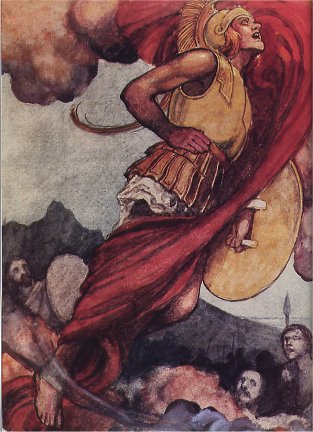 |
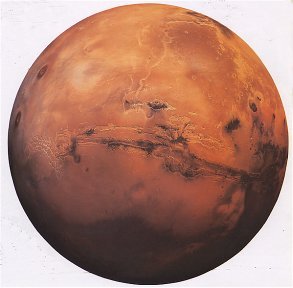 |
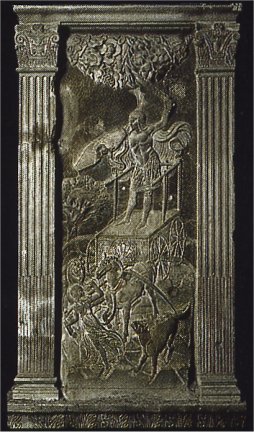 |
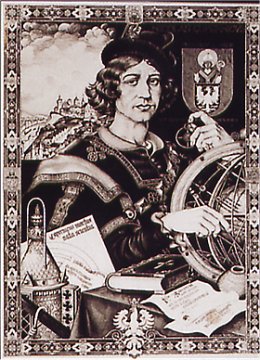
Polish astronomer Nicolaus Copernicus (1473-1543) declared in On the Revolutions of the Celetial Spheres, that the sun, not the Earth, was the centre of the universe. . |
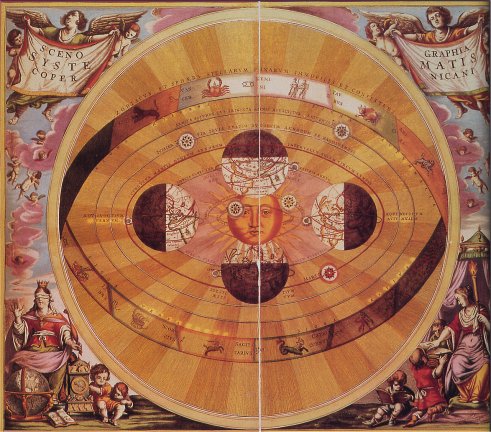
Scenographia: Systematis Copernicani Astrological Chart - 1543 Copernicus showed that the motions of the celestial bodies more easily could be understood if the Earth revolved around the sun. |
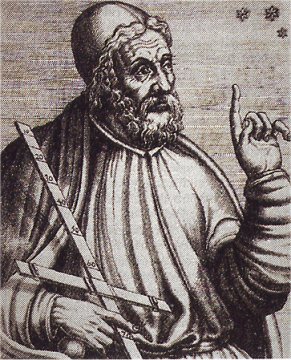
In 140 A.D. Claudius Ptolemy, a scholar from Alexandria, Egypt, expanded Eudoxus's theory of the planets that put Earth at the centre of the solar system. Although incorrect, Ptolemy's theory survived another 1,500 years. |
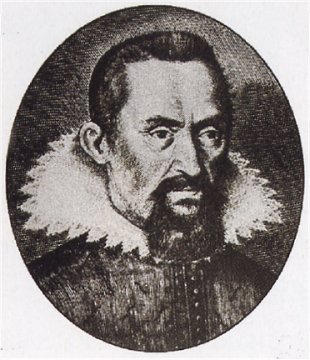
Johannes Kepler's breakthroughs in understanding and testing the principles of planetary laws laid the foundation for modern physics. |
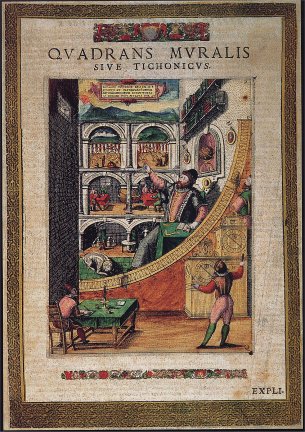
Tycho Brahe established Europe's finest observatory on the island of Hven in the late 16th century which revolutionized astronomy. Brahe invented the wall quadrant which enabled him to take precise measurements of the positions of celestial bodies. |
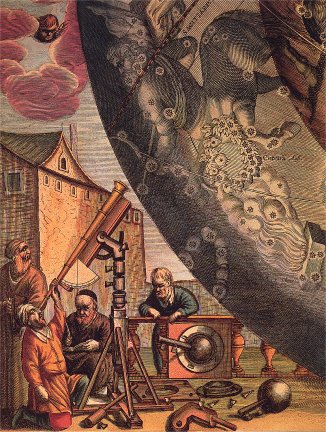
Early astronomers described and recorded what they saw in the heavens with great accuracy. . |
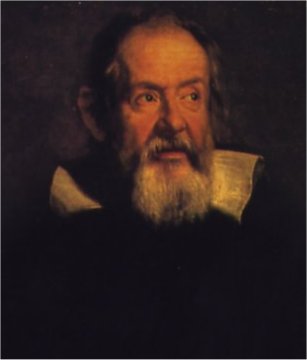
Galileo, the greatest of the early astronomers, observed the heavens and presented many theories in an attempt to explain the wonders he saw. |
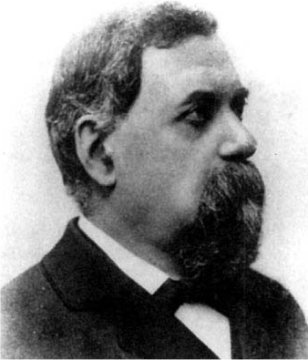
Giovanni Schiaparelli (1835-1910) Italian astronomer |
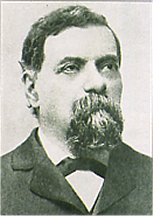
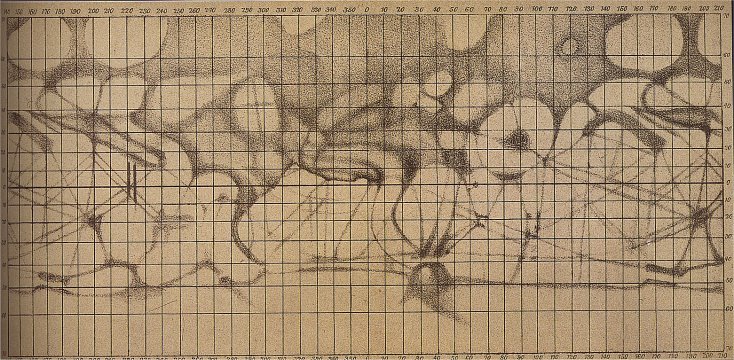
In 1877, Giovanni Schiaparelli, discovered a pattern
of irregular narrow lines
or dark streaks on Mars that he called canali (channels).
He did not suggest that intelligent beings built the
canals but others soon did so.
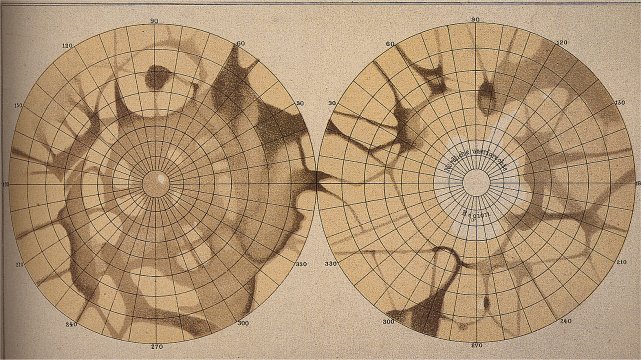
Telescopes in use in the late 19th century provided
unclear images
and much of the interpretation relied on the imagination
of astronomers.
Some saw crisscrossing lines (shown near the middle
of Schiaparelli's map)
and thought they were too long and straight to be
accidents of nature.
"That Mars is inhabited by beings of some sort of other we may
consider as certain as it is uncertain what those beings may be."
~ Percival Lowell
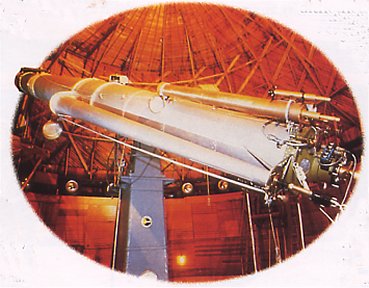
Percival Lowell's telescope In his 1896 book, Mars as the Abode of Life, he suggested that Schiaparelli's canali were a pattern of crisscrossing canals with "oases" at their intersections -- probably an irrigation network. This theory fired the imaginations of many future SF fans and writers. |
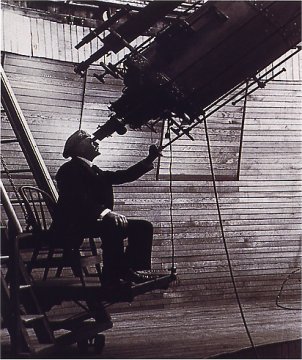
Percival Lowell observes Mars at his Flagstaff, Arizona observatory. His unyielding adherence to the idea of Martian canals and intelligent life stoked public enthusiasm for its exploration but led other astronomers to ostracize him. |
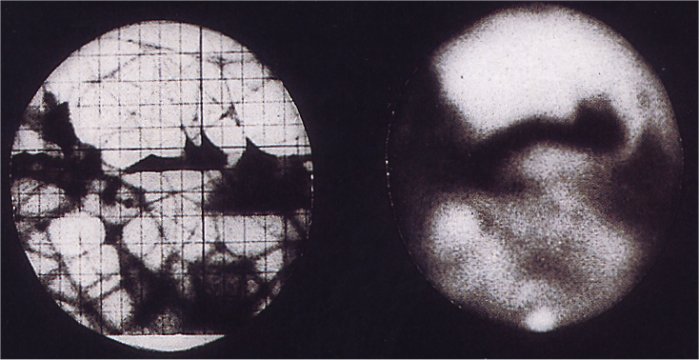
Early drawing of Mars canals (left) as seen by Percival
Lowell is juxtaposed with an actual photograph of the red planet.
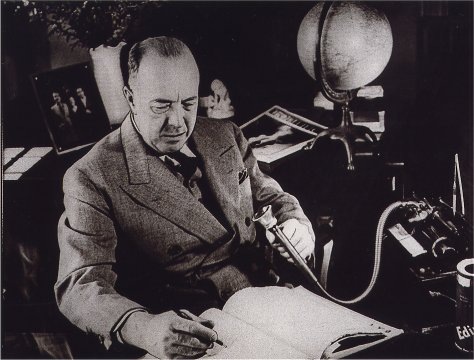
Edgar Rice Burroughs took the canal idea a step forward
and placed ancient civilizations
on a dying world kept alive by the canal system and
an atmosphere plant.
Burroughs' books on Mars, a planet that his fictional
Martians called Barsoom,
inspired many later science fiction writers, including
Ray Bradbury and astronomer Carl Sagan.
Another young reader who fell under Lowell's spell was Hugo Gernsback (see the ERB/Gernsback Connection ERBzine 1462 . . .) who went on to create a string of science invention and SF magazines such as Amazing Stories. One of his major illustrators was Frank Paul.
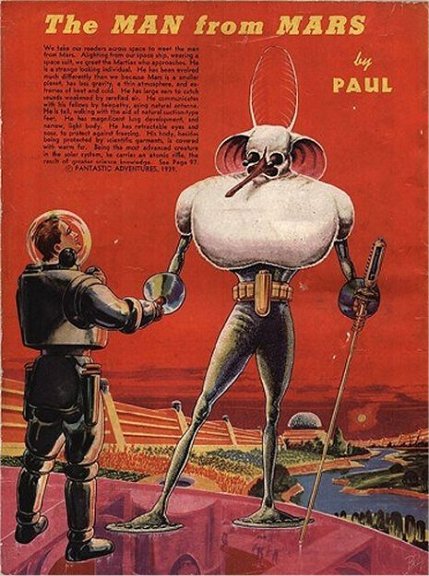
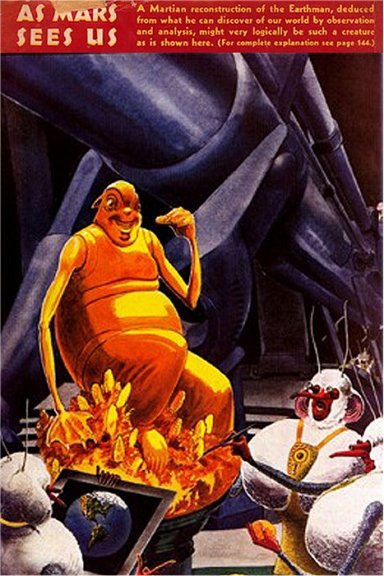
The possibility of life on the red planet has been discussed for ages.
Richard Proctor (1837-1888), wrote in his popular Other Worlds Than Ours (1870)
that the planet had seas and the oceans and was a miniature Earth. (Proctor Obituary)
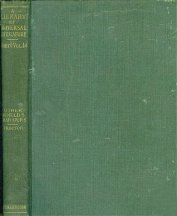
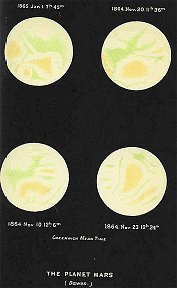
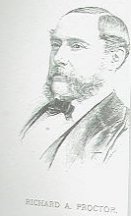
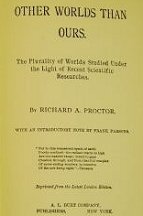
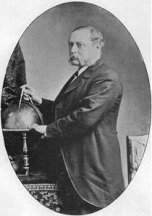
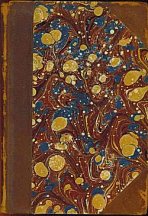
The preeminent French astronomer Camille Flammarion (1842-1925) popularized astronomy and cosmology, and discussed the physiological properties of extra-terrestrial life in his ground-breaking La Pluralité des Mondes Habités (The Plurality of Inhabited Worlds) (1862), Les Habitants de l'Autre Monde (The Inhabitants of Other Worlds) (1862), Les Mondes Imaginaires et les Mondes Réels (Imaginary and RealWorlds) (1864), and finally, Les Terres du Ciel (Lands in the Sky) (1884). The works of Flammarion had an immense infuence on the public, and the author remained convinced that there was life on Mars until his passing.
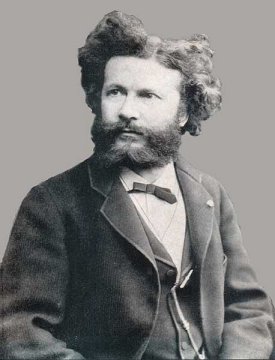
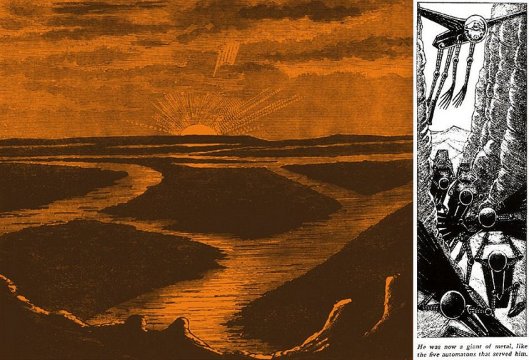
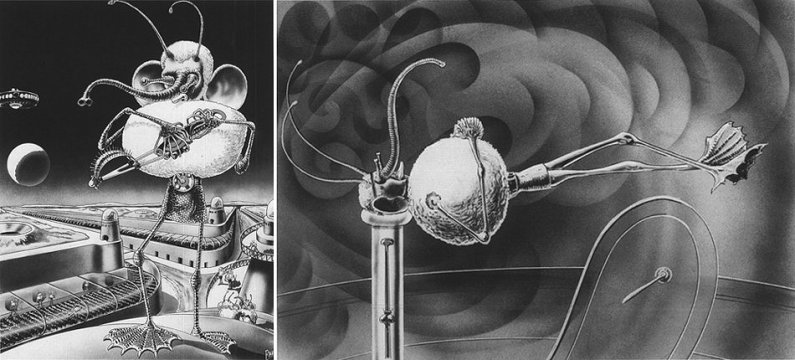
Speculation has cooled over the last century since the development of improved telescopic observations. Today much of this type of excitement and speculation has been transferred to a curiosity about UFOs.
The reason for all this excitement over Mars is understandable. Giovanni Schiaparelli (1835-1910), an Italian astronomer of the observatory of Brera, had asserted in 1877 to have seen canals on Mars. He believed that at least some of these canals must have been constructed by intelligent creatures. He speculated that they were colossal waterworks built by the inhabitants of the planet to carry meltwater from the polar ice caps to their cities, factories and irrigable land. Flammarion rejected the idea that the canals could simply be cracks in the ice or faults opened from the cooling of the planet since nature could never trace such straight lines on a globe. They could only be created by a species whose intelligence and and technology would be more advanced than ours.
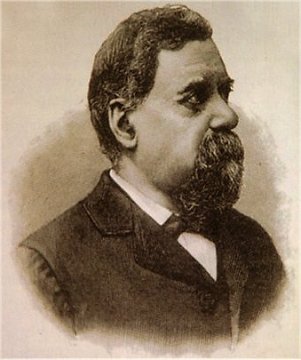
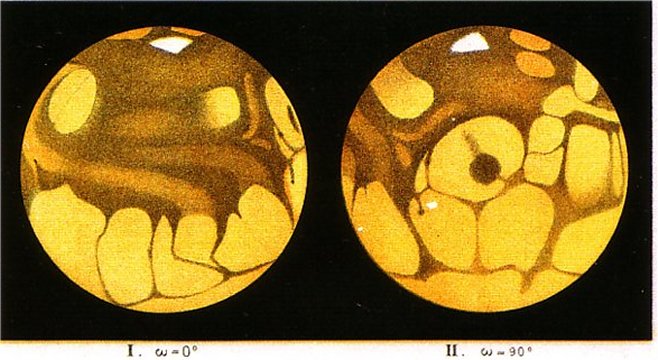
THE SECOND DEFINITIVE MARS MAP BY SCHIAPARELLI.
WITH AN IMPROVEMENT ON HIS OBSERVATIONS FROM 1877 AND 1888
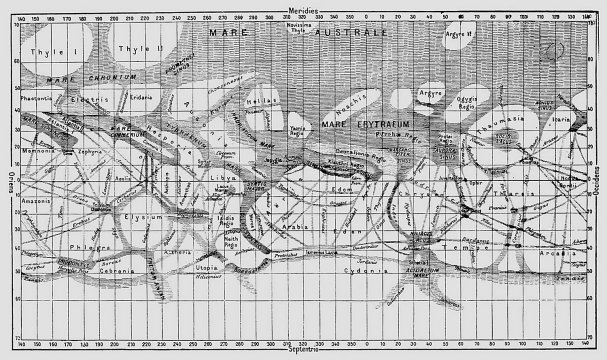
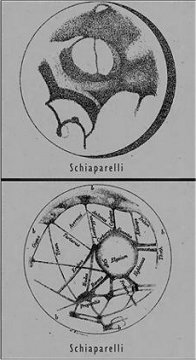
FOG-COVERED CANAL BY ©CHESLEY BONESTELL and A CANAL WITH VEGETATION
BY DAVID HARDY©
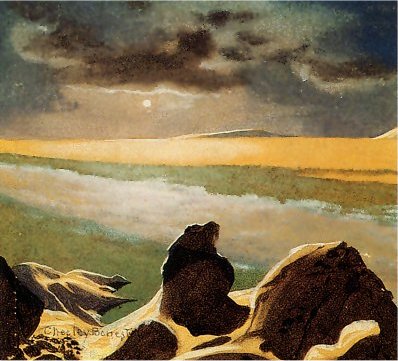
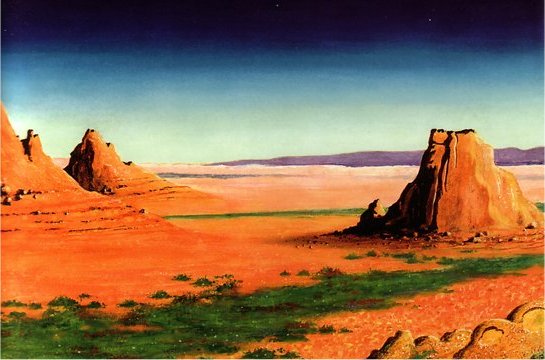

Percival Lowell's telescope In his 1896 book, Mars as the Abode of Life, he suggested that Schiaparelli's canali were a pattern of crisscrossing canals with "oases" at their intersections -- probably an irrigation network. This theory fired the imaginations of many future SF fans and writers. |

Percival Lowell observes Mars at his Flagstaff, Arizona observatory. His unyielding adherence to the idea of Martian canals and intelligent life stoked public enthusiasm for its exploration but led other astronomers to ostracize him. |

Early drawing of Mars canals (left) as seen by Percival
Lowell is juxtaposed with an actual photograph of the red planet.
PERCIVAL LOWELL And HIS ILLUSTRATIONS ©Lowell Observatory

Some hypotheses tried to explain the "channels" in other bizarre ways. Elihu Thompson, famous electrotechnical investigator, thought that they were traces of the passage of animals. He suggested that without wide mountains or rivers to hinder their march during their annual migrations the animals could move in straight lines. This gradually established of paths along which vegetation had been formed, while the rest of the planet is remained desert (Beloved Scientist - Elihu Thompson: To Guiding Spirit of the Electrical Age by David Or Woodbury 1944).Others suggested that Mars was a planet totally covered from the water and that the Mars ground seen through telescopes was really composed of enormous floating masses of algae. The channels would have been gaps in these masses caused by marine currents, through which the true surface of the planet could be seen at the bottom of the ocean.
MARTIAN LANDSCAPES (WITH CANALS) BY CHESLEY BONESTELL ©
Bonestell Space Art
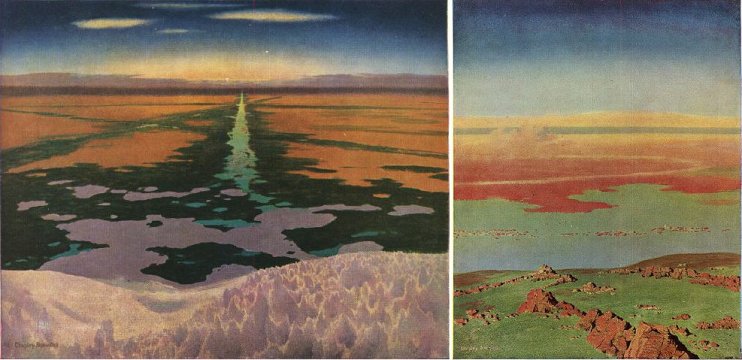
Lowell, and later H.G. Wells, agreed that the Martians could be quite different from us physically. Lowell in his book, Mars, of 1895 suggested that to speak about Mars inhabitants does not mean to say Martian men. Under different physical conditions life would evolve in ways we have no way of conceiving. Lowell carried on this argument in two later volumes, Mars and its Canals in 1907 and Mars as the Abode of Life in 1908.Lowell 437 channels, some as long as 1500 km. He was convinced that the Martians were industrious and benign and very intelligent to have created such a massive global project.
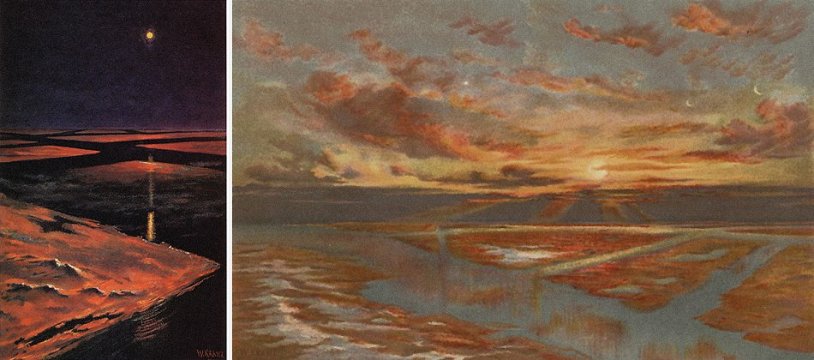
MARS AS VISIONED BY LUCIEN RUDAUX
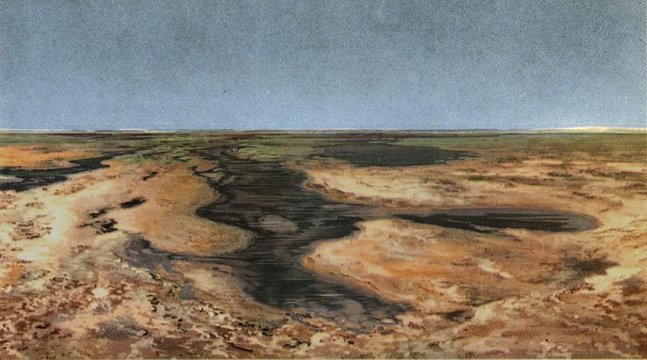
No one would have believed in the last years of the nineteenth century that this world was being watched keenly and closely by intelligences greater than man's and yet as mortal as his own; that as men busied themselves about their various concerns they were scrutinised and studied, perhaps almost as narrowly as a man with a microscope might scrutinise the transient creatures that swarm and multiply in a drop of water. ~ H. G. WELLS ~ THE WAR OFTHE WORLDS
In the article "The Things that Live on Mars," in the March 1908 Cosmopolitan Magazine, H. G. Wells tried by scientific reasoning to predict how Martians might look.
Through different evolutionary processes he felt that creatures on Mars would be very different from creatures on earth -- in shape, functions, structure and behaviors to the extent that they would be fantastically bizarre. Because of their high intelligence, they would likely have great brains with enormous skulls. They would be at least twice the mass of humans and would probably be covered with plumage or fur. As for the Martian fauna there would probably be no flies, sparrows, dogs or cats but it is possible that there would be insect life and there may be some form of aquatic creatures.
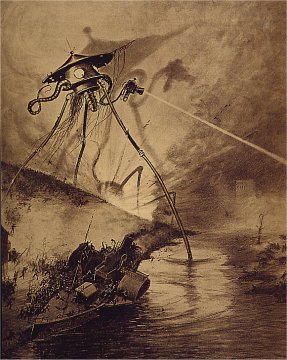
Martian spacecraft attack Earth in H.G. Wells ' The War of the Worlds. The Martian invaders shower terror on Victorian England with weapons of mass destruction. Chance, not human resourcefulness, ultimately saves the planet. |
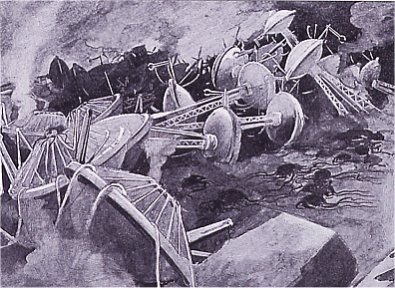
H.G. Wells's Martian Invaders "Across the gulf of space minds that are to our minds as ours are to the beasts that perish, intellects vast and cool and unsympathetic, regarded this earth with envious eyes . . ." .. |
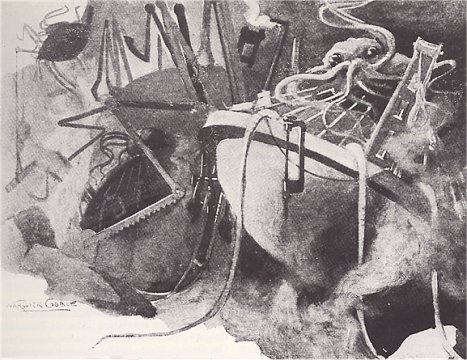
Warwick Goble illustration from the first serialization of The War of the Worlds in Pearson's Magazine - 1898. |
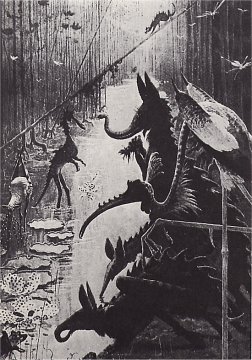
W.R. Leigh illustrations for "The Things That Live on Mars" as they appeared in the Midwinter 1908 issue of Cosmopolitan. |
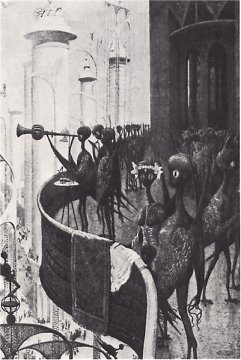
Reprinted in the article "Is Mars Inhabited?" by Prof. David Todd and H. G. Wells. |
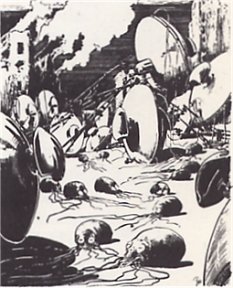
Frank R. Paul illustration in TheWar of the Worlds
reprint in Amazing Stories - 1927
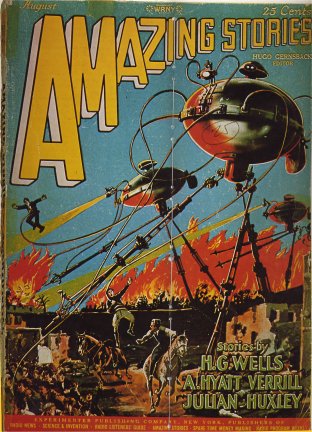
Frank R. Paul cover for The War of the Worlds reprinted
in Amazing Stories - 1927
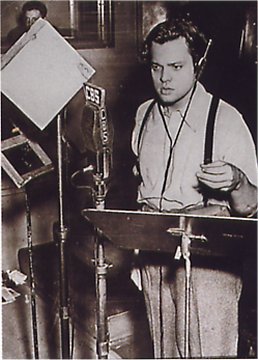
Orson Welles performing his radio adaptation of The War of the Worlds in the form of a live news account. The program triggered panic in listeners who believed the drama to be real. |
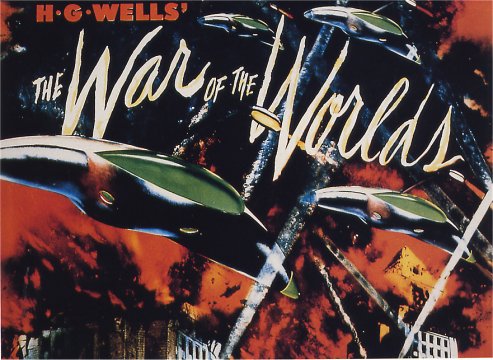
Poster from the 1953 Paramount movie. . |
Read the Orson Welles / Mercury Theatre radio script
of
The War of the Worlds (Invasion from Mars) HERE
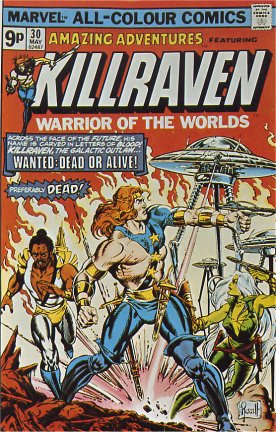
The more recent comic book: Killraven, Warrior of
the Worlds,
fighting the second comin of Wells's Martians.
ROMANTIC VIEWS OF "MARS THAT WAS"
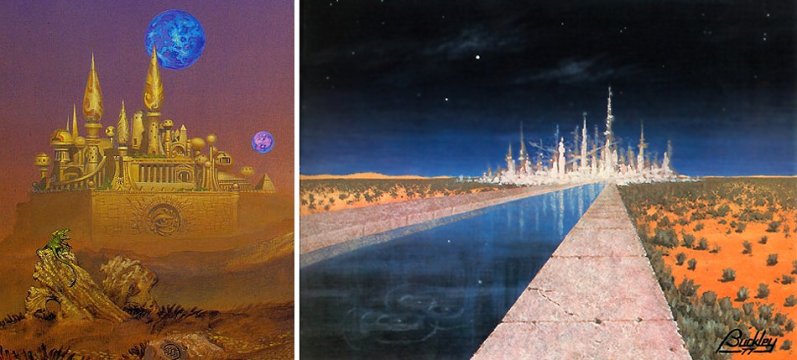
ILLUSTRATIONS FOR GULLIVER OF MARS
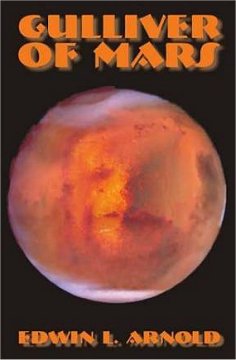

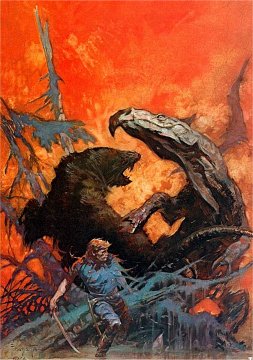
E-Text in ERBzine
![]()

![]()
BILL
HILLMAN
Visit
our thousands of other sites at:
BILL
AND SUE-ON HILLMAN ECLECTIC STUDIO
ERB
Text, ERB Images and Tarzan® are ©Edgar Rice Burroughs, Inc.-
All Rights Reserved.
All
Original Work ©1996-2010 by Bill Hillman and/or Contributing Authors/Owners
No
part of this web site may be reproduced without permission from the respective
owners.